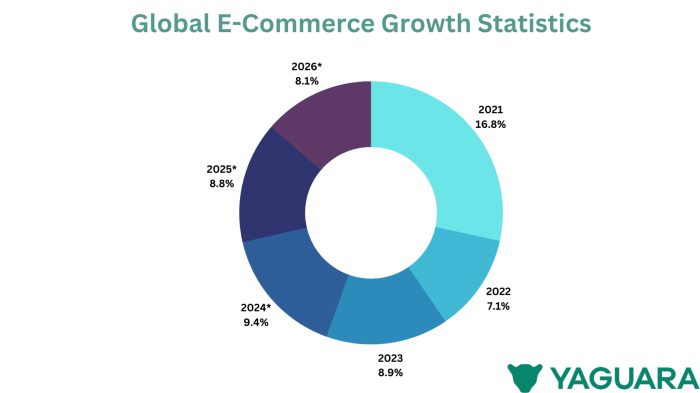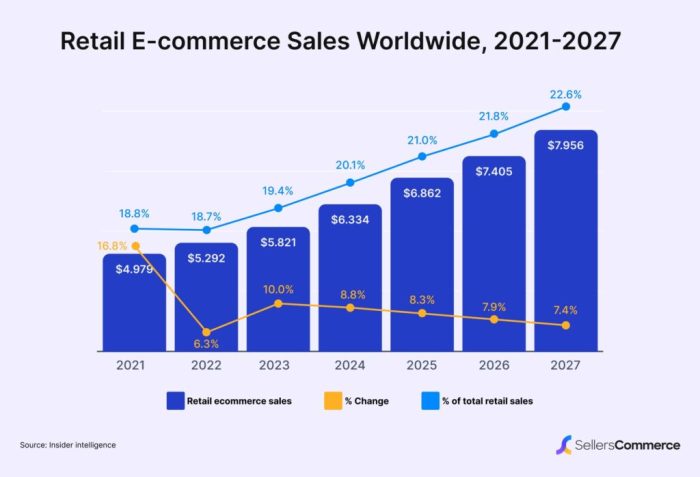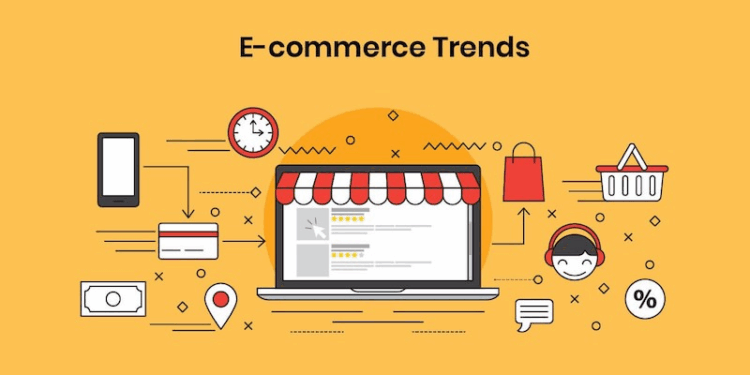
Embark on a journey through the dynamic landscape of ecommerce market growth, where key factors, global trends, challenges, and future projections converge to shape the industry's evolution.
Delve into the intricate web of technological advancements, consumer behaviors, and innovative strategies propelling the expansion of ecommerce on a global scale.
Factors driving ecommerce market growth

The ecommerce market has experienced significant growth in recent years, driven by a combination of factors that have reshaped the way consumers shop and businesses operate. Technological advancements, changes in consumer behavior, and innovative strategies have all played a crucial role in fueling this growth.
Technological Advancements
Technological advancements have revolutionized the ecommerce industry, making it easier for businesses to reach a global audience and for consumers to shop conveniently from anywhere. The widespread adoption of mobile devices, improved internet connectivity, and the development of secure online payment systems have all contributed to the rapid growth of ecommerce.
- Mobile Commerce (M-commerce): The rise of smartphones and tablets has enabled consumers to shop on-the-go, leading to a surge in mobile commerce. Businesses have optimized their websites and apps for mobile devices, providing a seamless shopping experience for customers.
- Artificial Intelligence (AI) and Machine Learning: Ecommerce platforms are leveraging AI and machine learning algorithms to personalize the shopping experience, recommend products based on customer preferences, and streamline the checkout process.
- Augmented Reality (AR) and Virtual Reality (VR): AR and VR technologies are transforming the way consumers interact with products online, allowing them to visualize products in a virtual setting before making a purchase.
Innovative Strategies
In addition to technological advancements, innovative strategies adopted by ecommerce businesses have also fueled market growth by enhancing customer engagement, improving logistics, and expanding market reach.
- Omni-channel Retailing: Ecommerce companies are integrating online and offline channels to provide a seamless shopping experience across multiple touchpoints. This approach allows customers to browse products online, make purchases in-store, and vice versa.
- Subscription Services: Many ecommerce businesses have introduced subscription services, offering customers the convenience of regular product deliveries at a fixed interval. This model not only fosters customer loyalty but also ensures a steady revenue stream for businesses.
- Marketplace Platforms: Ecommerce marketplaces like Amazon and Alibaba have created opportunities for small and medium-sized businesses to reach a larger customer base and expand their market presence without significant investment in infrastructure.
Global ecommerce market trends
The global ecommerce market is constantly evolving, driven by changing consumer behaviors and emerging markets. Let's delve into some of the current trends shaping the landscape of online retail.
Impact of changing consumer behaviors
Consumer preferences and habits have a significant impact on the growth of ecommerce. With the rise of smartphones and easy access to the internet, more people are turning to online shopping for convenience and a wider range of products. Additionally, the shift towards digital payments and the desire for personalized shopping experiences have also played a role in shaping the ecommerce market.
- Mobile commerce (m-commerce) is on the rise, with a growing number of consumers using their smartphones to make purchases on the go. This trend has pushed retailers to optimize their websites and apps for mobile devices to enhance the shopping experience.
- Personalization and customization are becoming key factors in driving consumer engagement and loyalty. Ecommerce platforms are leveraging data analytics and AI technology to deliver tailored recommendations and offers to individual shoppers.
- The demand for fast and convenient delivery options, such as same-day or next-day shipping, has fueled the growth of logistics and supply chain innovations in the ecommerce sector.
Emerging markets driving ecommerce expansion
While ecommerce is thriving in established markets like the US and China, there are several emerging economies that are experiencing rapid growth in online retail.
| Country | Key Factors |
|---|---|
| India |
|
| Brazil |
|
| Nigeria |
|
Challenges faced by the ecommerce industry
Ecommerce businesses face several challenges that can hinder their sustainable growth. These challenges range from logistical issues to cybersecurity threats that can impact the overall performance of the ecommerce market.
Cybersecurity Threats Impact
Cybersecurity threats pose a significant risk to ecommerce businesses, as they can compromise sensitive customer data, leading to loss of trust and reputation. It is essential for ecommerce companies to invest in robust cybersecurity measures to protect their platforms and customer information.
Logistical Challenges
Logistical challenges, such as shipping delays, inventory management issues, and supply chain disruptions, can impact the efficiency of ecommerce operations. To overcome these challenges, businesses can implement strategies like optimizing warehouse management, partnering with reliable shipping providers, and leveraging technology for better inventory tracking.
Future outlook for the ecommerce market
The future of the ecommerce market looks promising, with continued growth expected in the coming years. As technology advances and consumer behaviors evolve, the ecommerce industry is poised for significant expansion.
Projections for the future growth of the ecommerce industry
- Global ecommerce sales are projected to reach $6.3 trillion by 2024, demonstrating a steady upward trajectory.
- The Asia-Pacific region is expected to lead the ecommerce market growth, driven by increasing internet penetration and smartphone usage.
- Mobile commerce is anticipated to continue its rise, with more consumers opting for convenient shopping experiences on their smartphones.
Potential disruptions impacting the trajectory of ecommerce market growth
- Rapid technological advancements could lead to increased competition and the need for businesses to adapt quickly to stay ahead.
- Changes in consumer preferences and behaviors, influenced by factors such as sustainability and ethical practices, could impact purchasing decisions.
- Regulatory changes and cybersecurity threats pose potential risks to the ecommerce industry, requiring companies to enhance their security measures.
Artificial intelligence and machine learning shaping the future of ecommerce
- AI-powered personalization tools will play a crucial role in enhancing the shopping experience for customers, offering tailored recommendations and improving customer satisfaction.
- Machine learning algorithms will help ecommerce businesses optimize their operations, from inventory management to pricing strategies, leading to increased efficiency and profitability.
- Chatbots and virtual assistants powered by AI will continue to revolutionize customer service in ecommerce, providing instant support and driving engagement.
Last Recap

As we conclude our exploration of ecommerce market growth, we are reminded of the resilience and adaptability required to navigate the challenges and seize the opportunities that lie ahead in this ever-evolving industry.
Question Bank
What are the key factors driving ecommerce market growth?
The key factors include technological advancements, changing consumer behaviors, and innovative strategies implemented by businesses.
How do cybersecurity threats impact the growth of the ecommerce market?
Cybersecurity threats can lead to loss of consumer trust, financial losses, and reputational damage for ecommerce businesses, hindering their growth.
What are some projections for the future growth of the ecommerce industry?
The future of ecommerce is poised for continued expansion, driven by advancements in artificial intelligence, machine learning, and personalized customer experiences.











